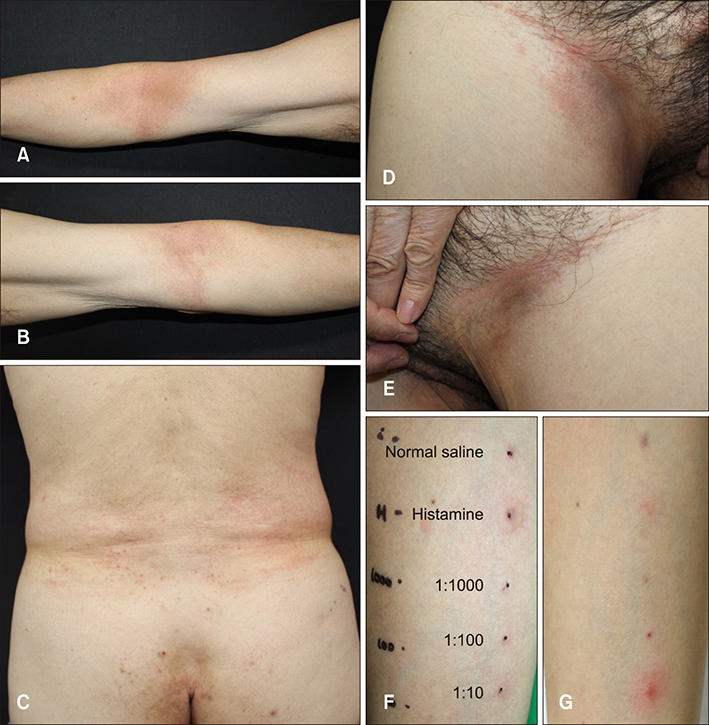Ann Dermatol.
2018 Oct;30(5):606-609. 10.5021/ad.2018.30.5.606.
Symmetrical Drug-Related Intertriginous and Flexural Exanthema: Two Cases and Brief Literature Review
- Affiliations
-
- 1Department of Dermatology, Chung-Ang University College of Medicine, Seoul, Korea. drseo@hanafos.com
- KMID: 2419754
- DOI: http://doi.org/10.5021/ad.2018.30.5.606
Abstract
- It has been reported that there are a range of causative drugs related to symmetrical drug-related intertriginous and flexural exanthema (SDRIFE). The causative drugs reported so far include the following: antibiotics, intravenous immunoglobulin, chemotherapeutic agents, and biologics. In this study, we report two cases of SDRIFE and a review of the previous literature. We believe that our study makes a significant contribution to the literature because it demonstrates that intradermal injection of the Chinese herbal ball, and not its topical application, elicited a reaction that predicted the occurrence of SDRIFE. This finding is important for the diagnosis of SDRIFE in future studies. Our findings also provide evidence for a SDRIFE reaction after exposure to ranitidine and mosapride.
Keyword
MeSH Terms
Figure
Reference
-
1. Tan SC, Tan JW. Symmetrical drug-related intertriginous and flexural exanthema. Curr Opin Allergy Clin Immunol. 2011; 11:313–318.
Article2. Barbaud A. Skin testing in delayed reactions to drugs. Immunol Allergy Clin North Am. 2009; 29:517–535.
Article3. Häusermann P, Harr T, Bircher AJ. Baboon syndrome resulting from systemic drugs: is there strife between SDRIFE and allergic contact dermatitis syndrome? Contact Dermatitis. 2004; 51:297–310.
Article4. Wolf R, Orion E, Matz H. The baboon syndrome or intertriginous drug eruption: a report of eleven cases and a second look at its pathomechanism. Dermatol Online J. 2003; 9:2.
Article5. Valks R, Buezo GF, Daudén E, Fraga J, García-Díez A. Eccrine squamous syringometaplasia in intertriginous areas. Br J Dermatol. 1996; 134:984–986.
Article6. Pichler WJ, Beeler A, Keller M, Lerch M, Posadas S, Schmid D, et al. Pharmacological interaction of drugs with immune receptors: the p-i concept. Allergol Int. 2006; 55:17–25.
Article7. Barbaud A, Tréchot P, Granel F, Lonchamp P, Faure G, Schmutz JL, et al. A baboon syndrome induced by intravenous human immunoglobulins: report of a case and immunological analysis. Dermatology. 1999; 199:258–260.
Article
- Full Text Links
- Actions
-
Cited
- CITED
-
- Close
- Share
- Similar articles
-
- Two Cases of Patients with a Rash along the Intertriginous Area without Certain Drug History
- A case of SDRIFE (symmetric drug-related intertriginous and flexural exanthema) associated with denosumab
- A Case of Symmetrical Lipomatosis of the Tongue and a Literature Review
- A Case of Generalized Granuloma Annulare Localized to the Intertriginous Area
- Piebaldism Associated with Café-au-lait Macules and Intertriginous Freckling: A Case Report and Review of the Literature



